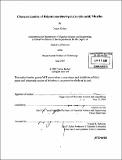Characterization of polystyrene-block-poly (acrylic acid) micelles
Author(s)
Kohen, Naomi (Naomi T.)
DownloadFull printable version (1.749Mb)
Other Contributors
Massachusetts Institute of Technology. Dept. of Materials Science and Engineering.
Advisor
Darrell J. Irvine.
Terms of use
Metadata
Show full item recordAbstract
Several parameters that affect the formation, size and spatial distribution of micelles of poly(styrene-block-acrylic acid) (PS-b-PAA) in organic solvents or assembled on solid substrates have been investigated. The micelles were characterized in the solvated state using Dynamic Light Scattering, and were imaged and characterized in the dry thin film state using Atomic Force Microscopy. Micelle size in solution followed scaling laws based on the ratio of the two block copolymer segments. Micelle size was not affected by the addition of PS homopolymer or salt, whereas micelle diameter did increase with the addition of PAA homopolymer both in solution and in the dry state on sold supports. Furthermore, micelles formed in toluene, but they did not form in tetrahydrofurane, chloroform or hexane. In terms of spatial distribution in the dry state, the only parameters which affected spacing, and therefore density, were annealing conditions and addition of PAA homopolymer. Annealing near or below the glass transition temperature for 16 hours increased the order of the films, as was demonstrated by Fast Fourier Transforms of their AFM images. Annealing for longer periods of time or at temperatures significantly above the glass transition temperature destroyed the micelles.
Description
Thesis (S.B.)--Massachusetts Institute of Technology, Dept. of Materials Science and Engineering, 2005. Includes bibliographical references (leaf 38).
Date issued
2005Department
Massachusetts Institute of Technology. Department of Materials Science and EngineeringPublisher
Massachusetts Institute of Technology
Keywords
Materials Science and Engineering.